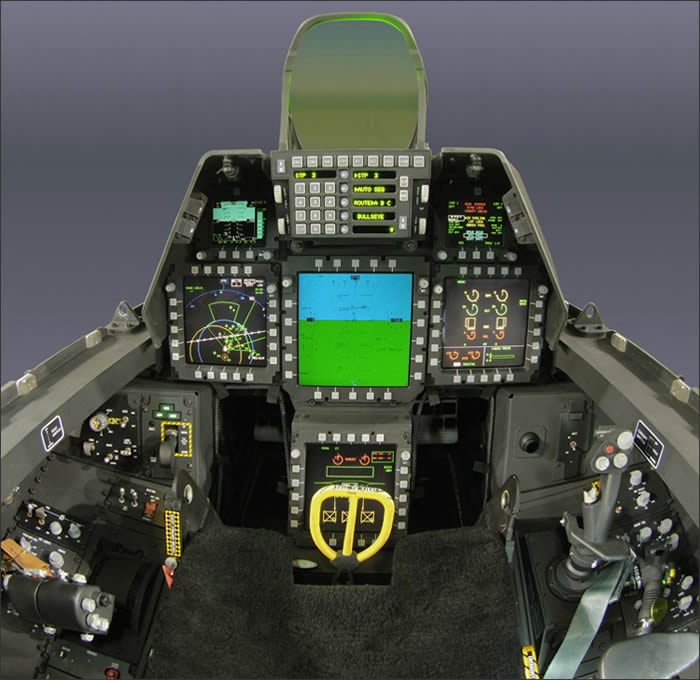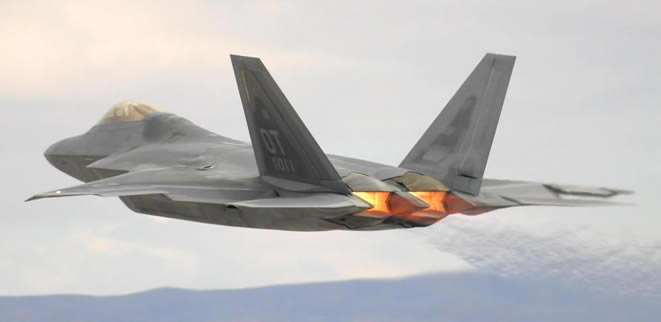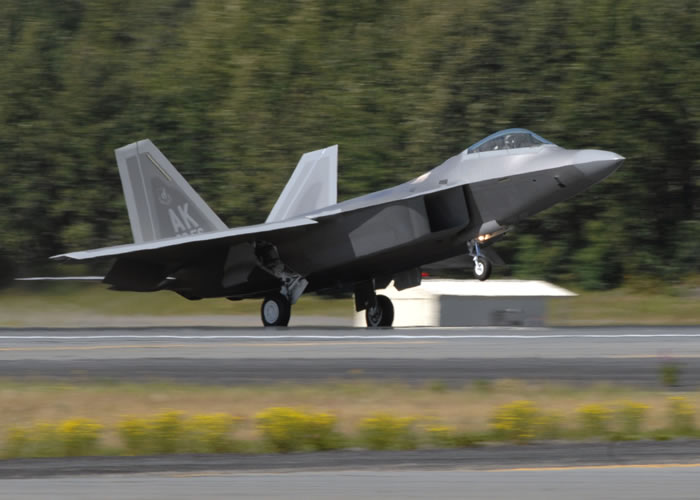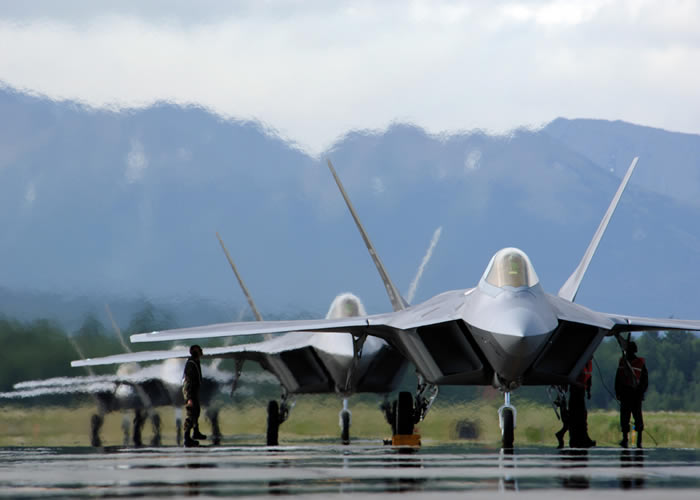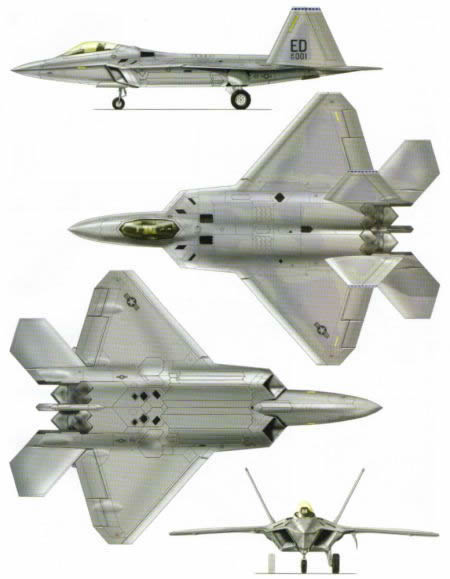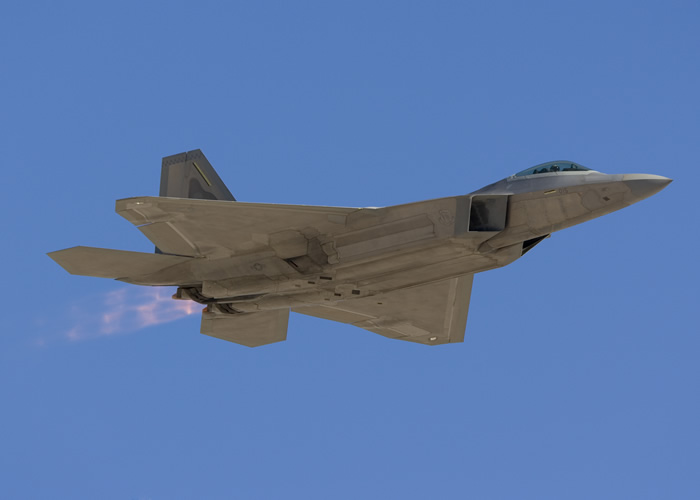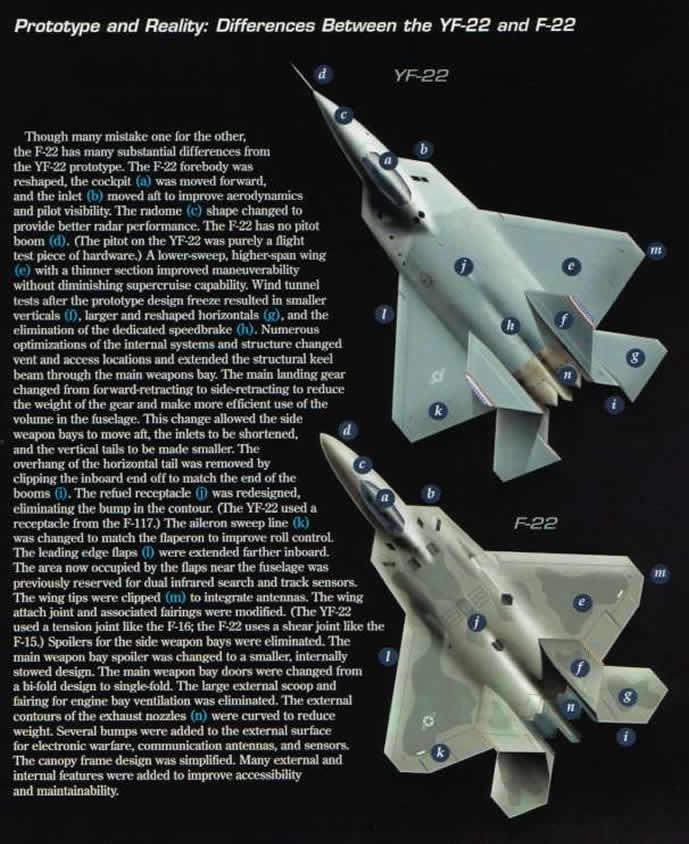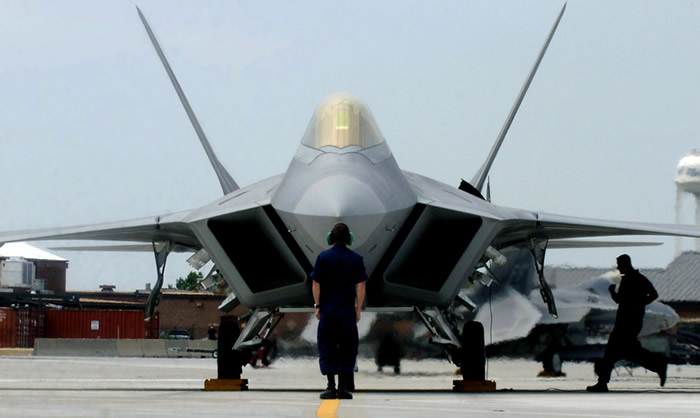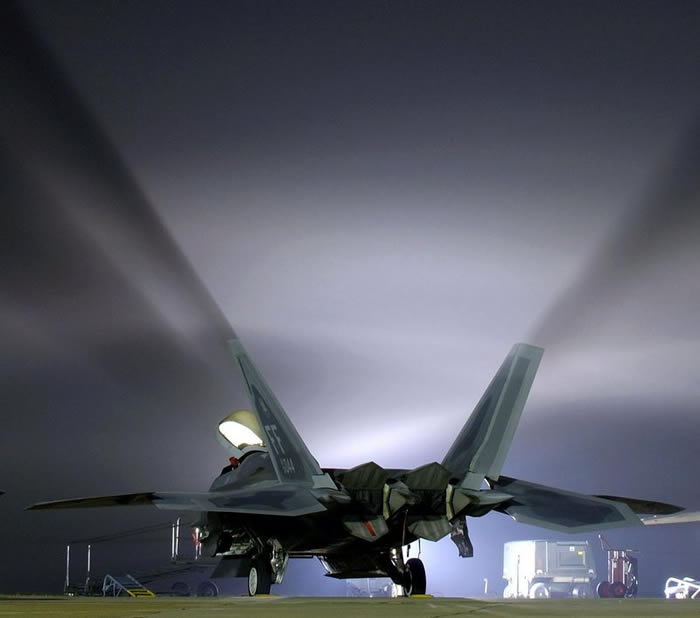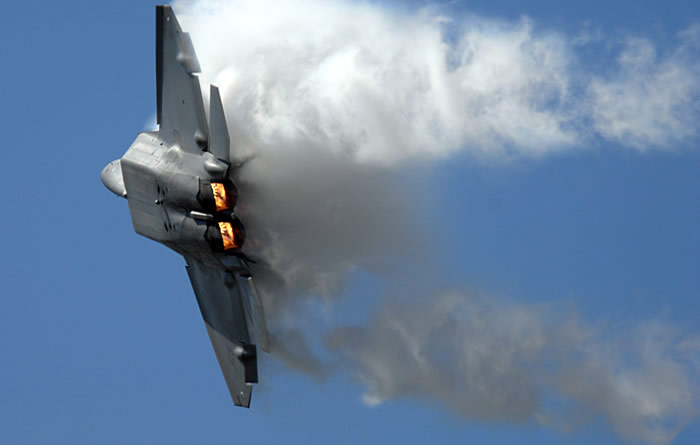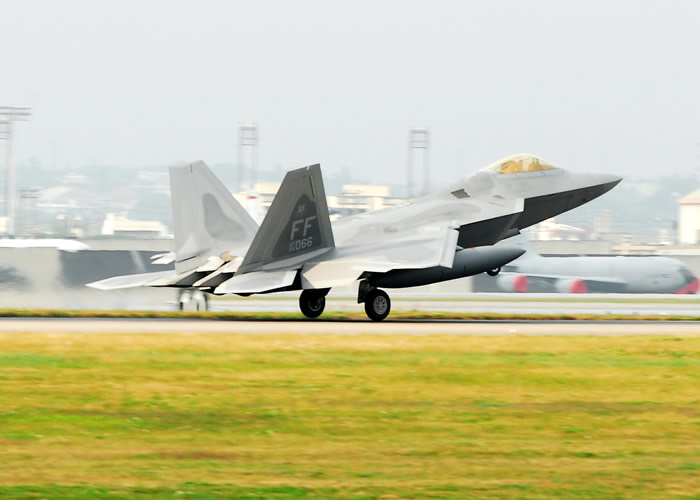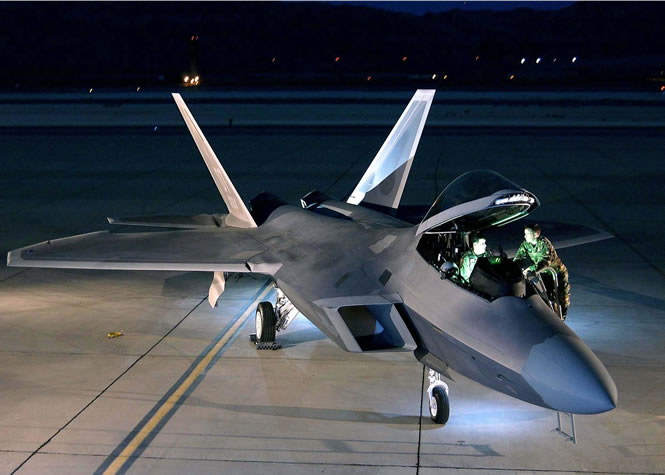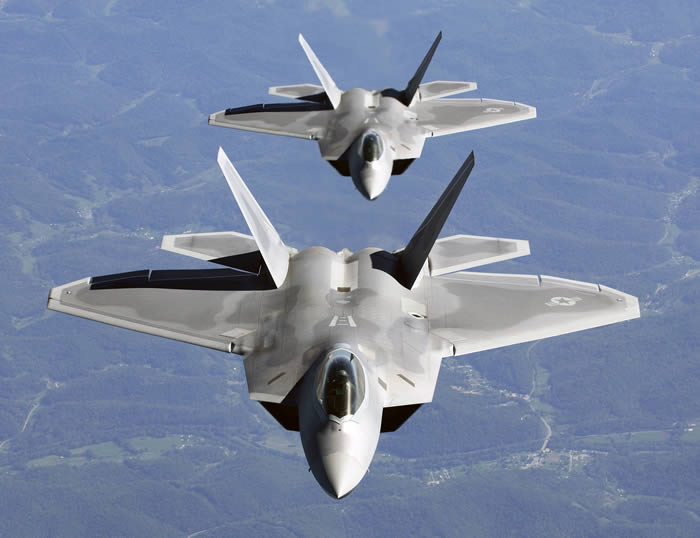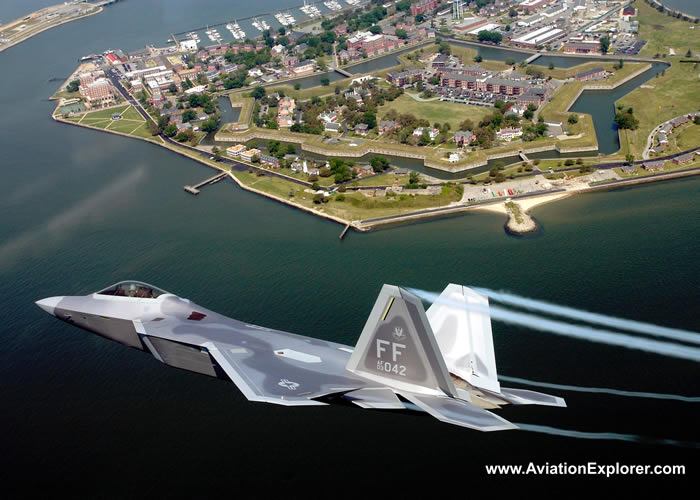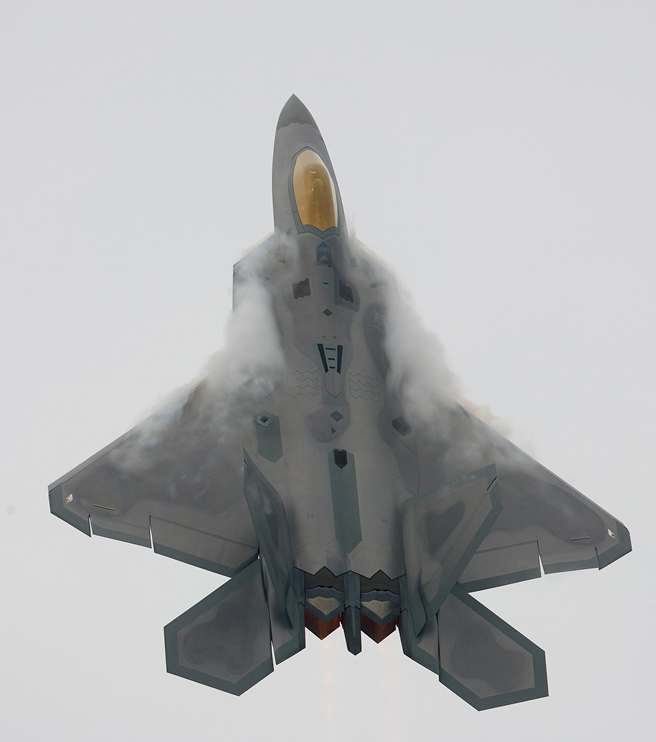US AIR FORCE F-22 RAPTOR AIRCRAFT
PICTURES HISTORY AND FACTS
 |
F-22 Raptor
The F-22 Raptor is an American fighter aircraft that utilizes stealth technology. It is an air superiority fighter, but is equipped for ground attack, electronic warfare and signals intelligence roles as well. The United States Air Force considers the F-22 a critical component of the US Global Strike Task Force. Faced with a protracted development period, the aircraft was variously designated F-22 and F/A-22 during the three years before formally entering United States Air Force service in December 2005, as the F-22A. Lockheed Martin Aeronautics is the prime contractor and is responsible for the majority of the airframe, weapon systems and final assembly of the F-22. Along with Lockheed Martin, partner Boeing Integrated Defense Systems provides the wings, aft fuselage, avionics integration, and all of the pilot and maintenance training systems.
Development The original Lockheed Advanced Tactical Fighter concept (1986)In 1981, USAF developed a requirement for a new air superiority fighter intended to replace the capability of the F-15 Eagle. It was envisaged that the ATF would incorporate emerging technologies including advanced alloys and composite materials, advanced fly-by-wire flight control systems, higher power propulsion systems, and low-observable/stealth technology.
A request for proposal (RFP) was issued in July 1986, and two contractor teams, Lockheed/Boeing/General Dynamics and Northrop/McDonnell Douglas were selected in October 1986 to undertake a 50-month demonstration/validation phase, culminating in the flight test of two prototypes, the YF-22 and the YF-23. The original Boeing Advanced Tactical Fighter concept (1986)Following a hard-fought fly-off competition, in August 1991 the YF-22 was declared the winner and Lockheed was awarded the contract to develop and build the Advanced Tactical Fighter. Into production The first crash of a production F-22 occurred during takeoff at Nellis Air Force Base on 20 December 2004, in which the pilot ejected safely moments before impact. The crash investigation revealed that a brief interruption in power during an engine shutdown prior to flight caused a malfunction in the flight-control system.
In August 2007, the United States Air Force signed a $5 billion, multi-year contract with Lockheed Martin that will extend production to 2011. In a ceremony on 29 August 2007, Lockheed Martin reached its "100th F-22 Raptor" milestone, delivering aircraft 05-4100. Procurement In April 2006, the cost of the F-22A was assessed by the Government Accountability Office to be $361 million per aircraft. This cost reflects the F-22A total program cost, divided by the number of fighters the Air Force is programmed to buy; and which has so far invested $28 billion in the Raptor's research, development and testing. That money, referred to as a "sunk cost", is already spent and is separate from money used for future decision-making, including procuring a copy of the jet. By the time all 183 fighters have been purchased, $34 billion will have been spent on actual procurement, resulting in a total program cost of $62 billion or about $339 million per aircraft. The incremental cost for one additional F-22 is around $137 million; decreasing with larger volumes. If the Air Force were to buy 100 more F-22s today, the cost of each one would be less than $117 million and would continue to drop with additional aircraft purchases.
F-22A Raptors over Utah in their first official deployment, October 2005. The F-22 is not the most expensive aircraft aloft. That distinction likely belongs to the roughly $2.2 billion-per-unit B-2 Spirit, whose orders went from hundreds to a few dozen when the Cold War ended thus making the unit cost skyrocket, though the incremental cost was under US $1 billion. The F-22 uses fewer radar absorbent materials than the B-2 or F-117 Nighthawk, which is expected to translate into lower maintenance costs. On 31 July 2007, Lockheed Martin received a multiyear contract for 60 F-22s worth a total of US $7.3 billion. During the recent grounding of nearly 700 F-15s, some U.S. Senators demanded that Deputy Secretary of Defense Gordon England release three government reports that support additional F-22 Raptors beyond the planned 183 jets. Forbes has reported that the USAF plans to extend the production of the F-22 past 2011. This is believed to a response to the recent grounding of F-15A-D. Proposed foreign sales
More recently Japan reportedly showed some interest in buying F-22As in its Replacement-Fighter program for its Air Self-Defense Force (JASDF). In such an event, it would most likely involve a "watered-down" export variant while still retaining most of its advanced avionics and stealth characteristics. However, such a proposal would still need approval from the Pentagon, State Department and Congress. Some Australian defense commentators have proposed that Australia purchase F-22 aircraft instead of the F-35. In 2006, the Australian Labor Party, Australia's main opposition party at the time, supported this proposal on the grounds that the F-22 is a proven, highly capable aircraft while the F-35 is still under development. The then-current Australian Government, however, ruled out the purchase of the F-22 on the grounds that it is unlikely to be released for export, and does not meet Australia's requirements for a strike aircraft. This assessment was supported by the Australian Strategic Policy Institute, a non-partisan, government-funded think-tank, which claimed that the F-22 "has insufficient multi-role capability at too high a price" for Australia. Israeli Air Force (IAF) chief procurement officer Brigadier-General Ze'ev Snir said that, "The IAF would be happy to equip itself with 24 F-22s, but the problem at this time is the US refusal to sell the aircraft, and its $200 million price tag." The US Congress upheld the ban on F-22 Raptor foreign sales during a joint conference on 27 September 2006. After talks in Washington in December 2006, the US DoD reported the F-22 would not be available for foreign sale.
Design Airframe Characteristics
The true top-speed of the F-22 is largely unknown to the general public, as engine power is only one factor. The ability of the airframe to withstand the stress and heat from friction is a further, key factor, especially in an aircraft using as many polymers as the F-22. However, while some aircraft are faster on paper, the internal carriage of its standard combat load allows the aircraft to reach comparatively higher performance with a heavy load over other modern aircraft due to its lack of drag from external stores. It is one of only a handful of aircraft that can sustain supersonic flight without the use of afterburner augmented thrust (and its associated high fuel usage). This ability is called supercruise. The F-22 is highly maneuverable, at both supersonic and subsonic speeds. The F-22's thrust vectoring nozzles allow the aircraft to turn tightly, and perform extremely high alpha (angle of attack) maneuvers such as the Herbst maneuver (or J-turn), Pugachev's Cobra, and the Kulbit, though the J-Turn is more useful in combat. The F-22 is also capable of maintaining a constant angle of attack of over 60°, yet still having some control of roll. During June 2006 exercises in Alaska, F-22 pilots demonstrated that cruise altitude has a significant effect on combat performance, and routinely attributed their altitude advantage as a major factor in achieving an unblemished kill ratio. Avionics
The AN/ALR-94 is a passive receiver system capable of detecting the radar signals in the environment. Composed of more than 30 antennae smoothly blended into the wings and fuselage, it is described by the former head of the F-22 program at Lockheed Martin Tom Burbage as "the most technically complex piece of equipment on the aircraft." With greater range (250+ nmi) than the radar, it enables the F-22 to limit its own radar emission which might otherwise compromise its stealth. As the target approaches, AN/ALR-94 can cue the AN/APG-77 radar to keep track of its motion with a narrow beam, which can be as focused as 2° by 2° in azimuth and elevation. The AN/APG-77 AESA radar, designed for air-superiority and strike operations, features a low-observable, active-aperture, electronically-scanned array that can track multiple targets in all kinds of weather. The AN/APG-77 changes frequencies more than 1,000 times per second to reduce the chance of being intercepted. The radar can also focus its emissions to overload enemy sensors, giving the aircraft an electronic-attack capability. A pair on patrol.The radar’s information is processed by two Raytheon Common Integrated Processor (CIP)s. Each CIP operates at 10.5 billion instructions per second and has 300 megabytes of memory. Information can be gathered from the radar and other onboard and offboard systems, filtered by the CIP, and offered in easy-to-digest ways on several cockpit displays, enabling the pilot to remain on top of complicated situations. The Raptor’s software is composed of over 1.7 million lines of code, most of which concerns processing data from the radar. The radar has an estimated range of 125-150 miles, though planned upgrades will allow a range of 250 miles or more in narrow beams.
The F-22 has several unique functions for an aircraft of its size and role. For instance, it has threat detection and identification capability along the lines of that available on the RC-135 Rivet Joint. While the F-22's equipment isn't as powerful or sophisticated, because of its stealth, it can be typically hundreds of miles closer to the battlefield, which often compensates for the reduced capability. The F-22 is capable of functioning as a "mini-AWACS." Though reduced in capability compared to dedicated airframes such as the E-3 Sentry, as with its threat identification capability, the F-22's forward presence is often of benefit. The system allows the F-22 to designate targets for cooperating F-15s and F-16s, and even determine if two friendly aircraft are targeting the same enemy aircraft, thus enabling one of them to choose a different target. It is often able to identify targets hundreds of times faster than accompanying dedicated AWACS.
The F-22's low probability of intercept radar is being given a high-bandwidth data transmission capability, to allow it to be used in a "broadband" role to permit high-speed relaying of data between friendly transmitters and receivers in the area. The F-22 can already pass data to other F-22s, resulting in considerably reduced radio "chatter." The IEEE-1394B data bus, developed for the F-22, was derived from the commercial IEEE-1394 bus system, often used on personal computers. The bus was subsequently deployed on the derivative F-35 Lightning II fighter. Armament As other air forces upgrade capabilities in the areas of air-to-air and air-to-ground munitions, one key aspect of the Raptor must be kept in mind. Its very high sustained cruise speeds, and operational altitude (something that is often ignored), add tremendously to the effective range of both air-to-air and air-to-ground munitions. Indeed, these factors could provide a strong rationale as to why the USAF has not pursued long-range, high-energy air-to-air missiles such as the MBDA Meteor. However the USAF plans to procure the AIM-120D AMRAAM, which will have a significant increase in range compared to the AIM-120C. The launch platform, in this case, provides the additional energy to the missile. This speed and altitude characteristic also helps improve the range of air-to-ground ordnance. While specific figures remain classified, it is expected that JDAMs employed by F-22s will have twice or more the effective range of munitions dropped by legacy platforms. In testing, a Raptor dropped a 1,000 lb (450 kg) JDAM from 50,000 feet (15,000 m), while cruising at Mach 1.5, striking a moving target 24 miles away. The SDB, as employed from the F-22, should see even greater increases in effective range, due to the improved lift to drag ratio of these weapons.
While in its air-superiority configuration, the F-22 carries its weapons internally, though it is not limited to this option. The wings are capable of supporting four detachable hardpoints. Each hardpoint is theoretically capable of handling 5,000 lb of ordnance. However, use of external stores greatly compromises the F-22's stealth, and has a detrimental effect on maneuverability, speed, and range. As many as two of these hardpoints are "plumbed", allowing the usage of external fuel tanks. The hardpoints are detachable in flight allowing the fighter to regain its stealth once these external stores are exhausted. Currently, there is research being conducted to develop a stealth ordnance pod and hardpoints for it. Such a pod would comprise a stealth shape and carry its weapons internally, then would split open when launching a missile or dropping a bomb. Both the pod and hardpoints could be detached when no longer needed. This system would allow the F-22 to carry its maximum ordnance load while remaining stealthy, albeit at a loss of maneuverability. However, there is concern over this program as external carriage of fuel tanks has shown more stress placed on the wings than originally anticipated. Stealth The stealth of the F-22 is due to a combination of factors, including the overall shape of the aircraft, the use of radar absorbent material (RAM), and attention to detail such as hinges and pilot helmets that could provide a radar return. However, reduced radar cross section is only one of five facets that designers addressed to create a stealth design in the F-22. The F-22 has also been designed to disguise its infrared emissions to make it harder to detect by infrared homing ("heat seeking") surface-to-air or air-to-air missiles. Designers also addressed making the aircraft less visible to the naked eye, controlling radio transmissions, and noise abatement. The F-22 apparently relies less on maintenance-intensive radar absorbent material and coatings than previous stealth designs like the F-117. These materials caused deployment problems due to their susceptibility to adverse weather conditions. Unlike the B-2, which requires climate-controlled hangars, the F-22 can undergo repairs on the flight line or in a normal hangar. Furthermore, the F-22 has a warning system (called "Signature Assessment System" or "SAS") which presents warning indicators when routine wear-and-tear have degraded the aircraft's radar signature to the point of requiring more substantial repairs. The exact radar cross section of the F-22 remains classified.
Operational history YF-22 "Lightning II" The prototype YF-22 won a fly-off competition against the Northrop/McDonnell-Douglas YF-23 for the Advanced Tactical Fighter contract. In April 1992 during flight testing after contract award, test pilot Tom Morgenfeld escaped without injury when the first YF-22 prototype that he was flying crashed while landing at Edwards Air Force Base in California. The cause of the crash was found to be a flight control software error that failed to prevent a pilot-induced oscillation. F-22 Raptor to F/A-22 and back again In September 2002, Air Force leaders changed the Raptor’s designation to F/A-22. The new designation, which mimicked that of the Navy’s F/A-18 Hornet, was intended to highlight plans to give the Raptor a ground-attack capability amid intense debate over the relevance of the expensive air-superiority jet. This was later changed back to simply F-22 on 12 December 2005. On 15 December 2005, the F-22A entered service.
Testing Raptor 4001 was retired and sent to Wright-Patterson AFB to be fired at for testing the fighter's survivability. Usable parts of 4001 would be used to make a new F-22. Another EMD F-22 was also retired and likely to be sent to be rebuilt. A testing aircraft was converted to a maintenance trainer at Tyndall AFB. On 3 May 2006, a report was released detailing a problem with a forward titanium boom on the aircraft that was not properly heat treated. Officials are still investigating the problem which was caused by the boom portion not being subjected to high temperatures in the factory for long enough, causing the boom to be less ductile than specified and potentially shortening the lives of the first 80 or so F-22s. Work is underway to restore them to full life expectancy. The F-22 fleet underwent modifications at Hill AFB, and at Edwards AFB near Palmdale, California.
Recent developments During Exercise Northern Edge in Alaska in June 2006, the F-22 downed 108 adversaries with no losses in simulated combat exercises. While attempting its first overseas deployment to the Kadena Air Base in Okinawa, Japan, on 11 February 2007, a group of six Raptors flying from Hickam AFB experienced multiple computer crashes coincident with their crossing of the 180th meridian of longitude (the International Date Line). The computer failures included at least navigation (completely lost) and communication. The fighters were able to return to Hawaii by following their tankers in good weather. The error was fixed within 48 hours and the F-22s continued their journey to Kadena. On 30 April 2007, the National Museum of the Air Force announced that EMD Raptor 91-4003 will be put on display in the space being occupied by the YF-22 sometime in July 2007 and prior to the USAF's 60th Anniversary celebration in October 2007. That particular Raptor is being refurbished in the restoration area of the Museum. There are plans to move the YF-22 to another museum and that will be decided in due time by the National Museum of the Air Force. In 2007, tests carried out by Northrop Grumman, Lockheed Martin, and L-3 Communications enabled the AESA system of a Raptor to act like a WiFi access point, able to transmit data at 548 Megabit/sec and receive at Gigabit speed; far faster than the current Link 16 system used by US and allied aircraft, which transfers data at just over 1 Megabit/sec. On 12 December 2007, the USAF officially declared the F-22 fully operational, three years after the first F-22 Raptor arrived at Langley Air Force Base. Variants Another more recent proposal is the FB-22, which would be used as a deep strike bomber for the USAF, but there has yet to be any word on whether the USAF plans further development of the program. Also, the X-44 MANTA, short for Multi-Axis, No-Tail Aircraft, is an experimental aircraft which itself is an F-22 with enhanced thrust vectoring controls and no aerodynamic backup (i.e. the aircraft is controlled solely by thrust vectoring, without rudders, ailerons, or elevators). It is scheduled to be tested some time in 2007. Operators Air Education and Training Command 325th Fighter Wing 43d Fighter Squadron - The only USAF squadron to operate F-22As at Tyndall AFB, Florida. The 43d was re-established at Tyndall in 2002, and, in 2003, with a corps of 15 Raptor Instructor Pilots, began training student Raptor pilots. The 43d continues to produce new Raptor pilots and serves as the focal point for all F-22 training of pilots and maintainers. Air Combat Command 1st Fighter Wing Langley Air Force Base, Virginia. 27th Fighter Squadron - The first deployable F-22 unit in December 2005 after receiving sufficient numbers of trained Raptor pilots and flew the first F-22A operational mission (January 2006 in support of Operation Noble Eagle). They deployed to Kadena Air Base with a complement of 250 Airmen and 12 F-22s. 94th Fighter Squadron - Full complement as of 19 January 2007. 53d Wing Eglin Air Force Base, Florida. 422d Test and Evaluation Squadron - The "Green Bats" are responsible for operational testing, tactics development and evaluation for the F-22. Air Force Material Command 412th Flight Test Squadron - Conducts developmental tests of F-22 enhancements and modernization. 3d Wing Elmendorf Air Force Base, Alaska. 90th Fighter Squadron - Conversion from F-15Es to F-22s begun; first F-22A arrived 8 August 2007. 525th Fighter Squadron - Not activated yet. 302d Fighter Squadron - An Air Force Reserve Command squadron that will convert from F-16s at Luke Air Force Base and move to Elmendorf AFB. Air National Guard 192nd Fighter Wing - Virginia Air National Guard. Transitioned from F-16s based in Richmond International Airport, Richmond, VA to F-22s based at Langley AFB, Virginia. Future bases and units will include: 199th Fighter Squadron, Hickam AFB, Hawaii. 531st Fighter Squadron, Hickam AFB, Hawaii. 49th Fighter Wing, Holloman AFB, New Mexico. Specifications (F-22 Raptor) General characteristics Crew: 1 Performance Guns: 1× 20 mm (0.787 in) M61A2 Vulcan gatling gun in starboard wing root, 480 rounds Note: It is estimated that internal bays can carry about 2,000 lb (910 kg) worth of bombs, and/or missiles. Four external hardpoints can be fitted to carry weapons or fuel tanks, each with a capacity of about 5,000 lb (2268 kg), while compromising, to a certain extent, the aircraft's stealth. Some armament is still largely classified. Aircraft in this size class since the F-105 have historically met a requirement of carrying maximum external payloads in the range of 14,000-15,000 lb with combat loads typically closer to 4,000-8,000 lb.
Avionics Popular culture |
© AviationExplorer.com - The Website For Aviation Enthusiasts |





